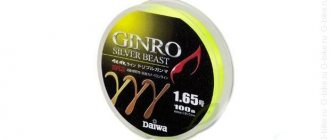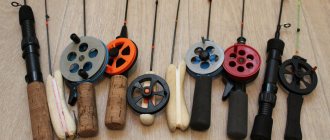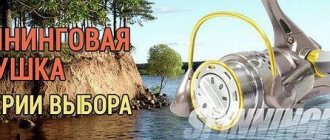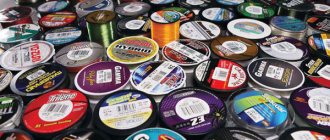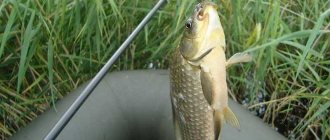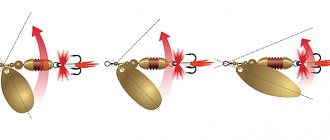Home » Basics » What is monofilament and how to secure it correctly when embroidering with beads?
Basics
Irina Vyshivaikina 06/12/2019
0
Monofilament for beads is a special thread that is used in embroidery. The main advantage of this thread is that it does not twist or separate during operation. Monofilament significantly simplifies the beading process and reduces the time wasted on straightening out the twists of regular thread. It is because of these qualities that monofilament has become so popular. Previously, needlewomen had to visit fishing stores and buy ordinary fishing line for their work, but with the popularity of fishing line, special monofilament threads were launched into handicraft stores.
What is monofilament for bead embroidery?
Many beginning needlewomen do not understand what monofilament for beads is. Monofilament for bead embroidery is a specialized thread that, like regular thread, is sold on a spool. This thread is often used in various types of sewing and beading. The thread got its name because it does not split in the longitudinal direction.
Manufacturers make monofilament from various materials:
- polyethylene;
- polyamide;
- nylon.
All these substances are easily melted at high temperatures and drawn out. The threads are pulled out with different forces, which will determine the thickness of the monofilament in the future. The main difference between monofilament and fishing line is its thickness. If the thickness of the fishing line is 0.3 - 1.5 mm in diameter, then the thickness of the monofilament is 0.1 - 0.3 mm.
Most often, needlewomen use white (transparent) bead thread. This color of monofilament is considered a classic in needlework and is often used in weaving and beadwork, working with sequins, leather, fur and shoe making.
Less commonly, black monofilament can be used in beading dark details. Of course, there is also colored monofilament on sale, but in practice it is used very rarely.
What it is
Monofilament, otherwise monofilament or monofilament line, is a single thread made from synthetic polymers .
Nylon fishing line (monofilament, copolymer, silicone) was created on the basis of the synthetic polyamide Nylon-66, invented in 1936 by DuPont (USA).
Nylon fishing line is an alternative to nylon. It has a number of differences, but is used much less frequently. Polycaprolactam monofilament was created in the USSR in 1948.
Monofilament has the following properties:
- equal thickness throughout;
- cross-section identical along the entire length;
- transparency.
Advantages and disadvantages
Like other materials, monofilament has its pros and cons. Advantages of monofilament in the process:
- the ability not to separate longitudinally and not to curl makes the process of working with monofilament quick and convenient;
- the strength of the monofilament will not allow the product to tear;
- the durability of the material will extend the service life of the product;
- does not fluff when cutting;
- it is possible to select the desired monofilament thickness;
- the thinnest diameter allows you to thread the thread through one bead several times;
- The transparent color of the monofilament will suit any product and fabric, and will not spoil the overall appearance of the work.

The disadvantages of monofilament in the process of handicrafts include:
- Excessive elasticity and insufficient strength of monofilament are not suitable for some work;
- the smoothness of the material does not allow you to quickly tie a knot;
- the materials from which monofilament is made cannot withstand high temperatures and can melt or deform when ironed;
- Some manufacturers' monofilament threads tend to stretch over time.
The quality of monofilament largely depends on the manufacturer, so if you do not have a proven, reliable manufacturer, take one spool of monofilament and only after checking its quality, buy more material.

A thread
There is a wide variety of threads on the modern market. But, as you already understand, we need to get a fairly strong and wear-resistant decoration, and therefore we will have to abandon threads made from natural fibers.
One type of durable thread is nylon. Nylon thread consists of synthetic fiber and tends to stretch slightly. A product made with such a thread will lie softer and will not bulge in unnecessary places. Nylon thread is perfect for weaving openwork collars and embroidery.
There are several types of nylon, and we are only interested in one type - nylon. In our country, these threads are often called nylon threads or as usual threads for sewing. The inscription on foreign Nylon threads should not confuse you. Perhaps the method of making nylon threads and nylon threads is slightly different, but essentially it is a synthetic polyamide fiber and it doesn’t matter what you call it.
I read that lavsan threads were created specifically for beadwork. These threads are less elastic, but they are no less durable. And the question of using lavsan threads or nylon threads is a matter of taste and habit. While I was writing this article, I decided to try a skein of lavsan threads that I bought for testing. The most difficult thing about working with them is threading the needle for the first time. The tail of the thread is constantly fluffy. But as it turned out, you just need to dip this tail in wax and all problems are solved. Lavsan thread does not twist during embroidery, unlike nylon thread. And, in my opinion, it is more convenient to work with her. But if it is not possible to purchase several skeins of lavsan threads at once, then you can get by with nylon thread.
Using good quality thread will avoid situations where the fibers bunch up in a clump at the eye of the needle. It is important that the thread does not become shaggy, otherwise the product will take on a sloppy appearance. And when choosing threads, their color plays an important role: whether it will match the beads or, on the contrary, contrast with them - it depends on your goals.
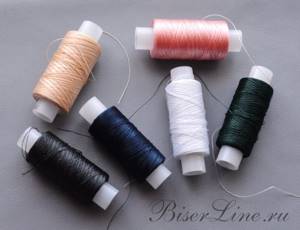
Preparing tools
The most basic step before creating a product of any size and complexity is the preparation of materials and tools.
You should purchase in advance:
- Beads. The main material in beading. It is best to purchase beads from European manufacturers (Czech, German). Compared to Chinese ones, it is of better quality and more durable. If you do not purchase ready-made embroidery kits, but create the product yourself, decide in advance on the color, shape and texture of the beads. Most often, round beads are used, although you can create embroidery from oval, triangular, and rectangular beads. You should also decide in advance on the diameter of the beads.
- Monofilament. Be sure to decide on the diameter of the monofilament before purchasing it. To work with larger beads, you will need monofilament with a larger diameter. When working with fine-grained beads, a thin synthetic thread is suitable.
- Wire. If your product contains complex decorations in the form of shapes and flowers, wire will help you create them. Its diameter is indicated on the packaging; the thicker it is, the more securely the product itself will hold.
- Needles. The needle is selected to the size of the beads of the future product. Not every needle is suitable for working with beads; some of them simply will not fit into the hole of the bead, so the needle is selected directly for the bead itself. The higher the number of needles on sale, the thicker the needle itself. During operation, needles may break, so we recommend purchasing several needles at once.
- Hoop. Most often they are used by beginning needlewomen. Some craftswomen find it more convenient to work with a hoop, since it is difficult to embroider on soft fabric without them. Before embroidering, the canvas is sewn to strips of fabric on a wooden hoop; you can also use a classic round hoop. If the embroidery is small, it will be convenient to work on a hoop, but if the product is large, they are simply not used.
- Take care of auxiliary tools: scissors, ruler, extra needle, table lamp.
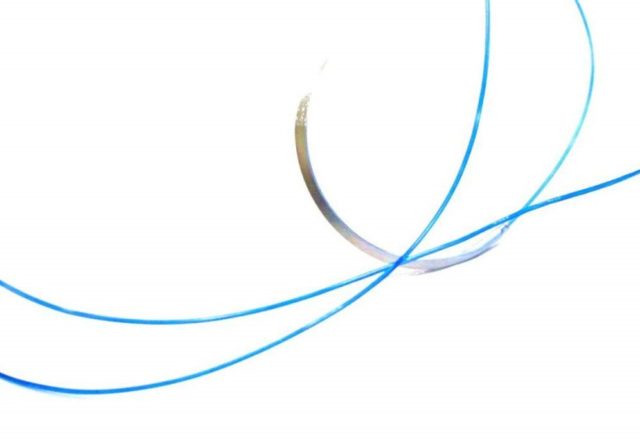
How to choose the right one
When choosing monofilament, the angler must clearly understand for what fishing method and in what conditions he will have to use the fishing line. Accordingly, he must pay attention to the following parameters:
- Diameter and breaking load.
The best would be monofilament, in which the breaking load will be maximum with a minimum diameter. - Calibration
The monofilament should have the same thickness along its entire length. - Color.
The color is selected based on the fishing conditions. In most cases, colorless line with maximum transparency is suitable. Sometimes it is better to choose a color based on the color of the water, for example, yellow for fishing in peat bogs, blue for fishing in crystal clear water, green for fishing among thickets of vegetation. For carp fishing, brown or black fishing line is used. - Extensibility.
Some monofilaments have reduced elongation. These lines can replace braided and fluorocarbon. - Memory.
The lower the memory, the better. You can forcefully pull the monofilament between your fingers and see if it curls in rings or remains relatively straight. - Rigidity.
Both soft and hard fishing lines are in demand - it all depends on the fishing conditions. The degree of rigidity can be determined by unwinding some line from the spool and seeing how it hangs to the floor - in rings or relatively straight. - Wear resistance.
When fishing on the bottom, which can cause damage to monofilament, it is recommended to use a line that is coated or one that states that it has increased abrasion resistance. - Strength at knots.
With the seller's permission, you can tie a simple knot and try to break the monofilament - smoothly and jerkily. The general impression you can get is that if a monofilament breaks like a rotten thread, it is better not to buy it.
Expert opinion
Knipovich Nikolai Mikhailovich
Zoologist, hydrobiologist. I am interested in fishing at a professional level.
Attention! The quality of the monofilament is directly indicated by the quality of the packaging. The packaging must be flat with clearly written text. If an expiration date is indicated, you should make sure that the monofilament is not expired.
How to embroider with beads using monofilament?
The process of bead embroidery itself is no different from embroidering with regular thread. It is important to choose the correct thickness of monofilament thread for bead embroidery. The most optimal diameter for work is 0.15 - 0.20 mm, and if larger beads are used - 0.2 - 0.3 mm. The main thing is to use monofilament that matches the diameter of the beads. The thinner the monofilament is used, the softer the product will be in the future. However, if you use monofilament for beaded jewelry, you should choose a thicker thread so that the beads do not stretch the fishing line in the future when wearing the jewelry.
One of the most important stages of the entire work is attaching the monofilament at the beginning and end of the work. Many beginning needlewomen do not really know how to fasten monofilament when embroidering with beads, since it tends to come undone due to its smooth structure. The main task when attaching monofilament is to ensure that it holds securely and at the same time is not noticeable at all from both the front and back sides.
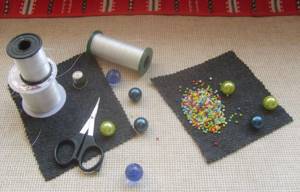
Most often, to attach the monofilament, a double knot is made at the end, which will not allow it to pass through the threads of the main fabric on which the embroidery is being done. For better reliability, the first few beads are stitched twice, and the same is done when finishing the work. When completing the embroidery, secure the knot of thread to the wrong side of the fabric; using a needle, you can try to hide it in the middle of the last bead. Some needlewomen do not know how to secure monofilament thread when embroidering brooches with beads.
For better reliability, many coat the monofilament knot itself with clear varnish. The disadvantage of this method is that this knot will definitely be noticeable, but it will definitely not untie.
In addition to bead embroidery, monofilament has proven itself in the following beading techniques:
- mosaic;
- Ndebele;
- mesh;
- for weaving plaits;
- for necklace stands;
- for creating boxes;
- for making toys.
Monofilament is not suitable for bead embroidery and cutting.
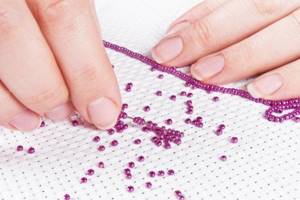
Beading and choice of materials: fishing line, monofilament or thread.
Beading is one of the most popular types of needlework, which involves women of all ages and even men!
Like any other creative activity, beadwork gives us a good mood from the manufacturing process and its result, and in order for the work process to be enjoyable and the result of the work to meet our expectations, it is very important to choose the right materials for a specific idea. The foundation of any bead product will be its base - fishing line, monofilament or thread. You can take the most expensive and even beads, but if the base is chosen incorrectly, the product will not work out, or will lose its appearance very soon during use, and your time and labor will be wasted.
Fig.1 Related Beading Products
How to choose a suitable base for beaded jewelry?
The choice will be correct if the properties of the base coincide as closely as possible with the requirements for the finished decoration. Let's take a closer look at the properties of different types of foundations, their advantages and disadvantages.
Fishing line and monofilament for beading.
Fig.2 Thread for beads (monofilament) Fig.3 Fishing line for beading
The fishing line can be used for fishing or specialized for beading. The beading line is adapted for creativity, available in sizes suitable for working with beads, and can be transparent, black or colored.
Monofilament is made for sewing clothes (can be used on any sewing machine), but is perfect for beading and bead embroidery. General characteristics of Beading and Monofilament Lines:
- thin, durable and resistant to moisture (sweat), does not cause allergic reactions upon contact with skin - transparent base, invisible in the finished product. When weaving with beads on a fishing line, there is no need to match the color to the beads, but if desired, you can use black or colored fishing line or monofilament. - a smooth base on which the beads move perfectly, there are no problems with putting on the needle - the single structure of the fishing line and monofilament does not delaminate during the process of repeated passage through the beads with a needle like a thread, which means it is easier to redo the finished part if necessary, and a precedent for breaking is not created. - when using a line for beads or monofilament, the product acquires additional density, which is an advantage for some beading techniques, but a disadvantage for others - the “memory” effect helps maintain the shape of the finished product, when working with monofilament or fishing line for beads, perhaps more than when When working with threads, it is important to be able to choose the optimal tension. -tearing bead fishing line or monofilament by hand can be quite difficult, but when working with cutting, glass beads or poorly processed stone chips, the base can easily tear. - when tying a knot (increasing the length of the working thread or when completing a product), it is necessary to make several knots to prevent them from slipping when stretched. Differences between bead fishing line and monofilament line:
- Monofilament is stronger, as a result of which the optimal diameter for working with beads is 0.15-0.2 mm, while diameters of 0.2-0.3 mm are popular for fishing line. The thinner the base, the more passes you can make through each bead. The thinner the fishing line or monofilament, the softer your finished product will be. -When stretched, the line breaks, and the monofilament stretches and thins before breaking. It is recommended to use fishing line and monofilament in products with dense weaving (beading techniques: mosaic, ndebele, mesh (with a small amount of beads in the loop). They are suitable for making woven ropes of beads and beads based on mesh, necklaces, voluminous bead toys , for braiding eggs or boxes with beads. Fishing line and monofilament are perfect for embroidery with beads and sequins. Fishing line and monofilament can be used to make single-row beads of small length. Fishing line and monofilament are not suitable for making openwork collars based on mesh, they are not suitable for jewelry that should be movable and “flowing”, are not suitable for multi-row beads and multi-row beads (especially if the beads are small). Due to the fact that fishing line and monofilament are easily cut, they are not suitable for embroidery with cutting and bugles. Go to the category fishing line, monofilament, spandex (elastic) in our catalog
What types of threads are there, what they are suitable for and how they differ from each other.
Fig.4 Threads (cotton) Fig.5 Polyester threads (shoes)
It would seem - what could be simpler than thread? So the strings are the most difficult thing. Not all threads are suitable for working with beads, even if their thickness allows you to squeeze into a bead eye. Let's take a closer look. Sewing threads are used for beading; they, in turn, can be used for clothing, shoes, and embroidery. All sewing threads are marked by composition and thickness, which makes it easier to navigate when choosing.
Types of marking of sewing threads:
1-according to the raw material composition, sewing threads are: -natural: cotton (CB), linen, silk -chemical: lavsan (L), nylon (K) -combined threads, lavsan base and additional thread: cotton (LH), linen (LL) ), woolen (LS); as well as reinforced threads (AN)
2-thickness sewing threads are marked in one of 4 ways: - metric numbering Nm (the number of meters of a single thread in a gram) - label numbering No. (the number of meters of thread in a gram without specifying the quantities of its addition) - the English NeB (a method similar to label marking, but for the value expressed in yards and pounds. The number of folds of the thread is indicated through a fraction. This numbering is used only on cotton threads, and if the number of folds is three, then this is simply not indicated, since it is the most popular). -international classification tex (tex is expressed as a numerical value equal to the weight in grams of 1000 meters of thread, after the symbol x the number of folds of the thread is indicated).
For synthetic threads, the numbering most often has a direct connection with its thickness; the higher the number, the thicker the thread. Threads made from natural materials are marked the other way around; greater thickness will have a lower number.
3-according to the number of folds (twisting), the threads are: elementary and complex.
Elementary ones consist of one thread, which cannot be divided into component “veins,” while complex ones consist of two or more elementary threads twisted together. Marking the twist of the thread is carried out together with marking the thickness of the thread, and has already been described by us in the previous paragraph.
Let's look at the types of threads suitable for beading and their features.
1. Cotton threads are the most common and affordable type of sewing thread; they have a wide palette of colors, which is undoubtedly an advantage when choosing a base, and, as a result, many beginning Craftsmen purchase them for working with beads. During operation, these threads can behave normally, but they are not suitable for everything, and you need to take into account that they do not like friction and water, in addition to shrinkage and deformation of the product from getting wet, they can simply rot from humidity. You cannot use cotton threads in products intended to be worn on the skin (woven necklaces, collars, bracelets). Products made with cotton threads should be protected from excessive exposure to the sun and should never be wetted. You can use cotton threads for embroidered brooches and pendants on a lining, braiding eggs and boxes with beads, and for embroidering paintings with beads. 2.Silk threads - durable, smooth, bright and rich colors. They are suitable for beading, but are found less and less often in stores, as they are gradually being replaced by more affordable complex synthetic analogues. Due to its high smoothness, silk thread can sometimes be difficult to tie, knots can unwind, you should pay attention to this. 3.Dacron thread - similar in structure to cotton threads, but at the same time cheaper and stronger. Mylar threads are not afraid of moisture and sun, the color of the thread is resistant to water, light and temperature, and their tensile strength is also much higher than that of cotton thread. Mylar threads are perfect for working with beads. The disadvantage of lavsan thread is that its ends become fluffy and inserting such a thread into a needle can be problematic. 4. Nylon thread is wear-resistant, durable, strength is lost from excess sunlight or when heated, a little moisture will not spoil it, but if it gets wet, it can become more elastic and the product is deformed. Nylon thread spins, as a result of which it gets tangled more often than others, just as lavsan thread can get fluffy at the ends. Can be used for beading, but will most likely cause you a lot of trouble. 5. Combined threads, accordingly, have the properties of the threads from which they are composed. Reinforced threads also belong to the combined category, but they are much better in many of their characteristics, and their core and braid are polyester. Smooth, durable, moisture-resistant, not afraid of chemicals and high temperatures, but have a little elasticity, which is not always necessary in the finished product.
General information about beading on threads:
-threads with a smooth structure like to unravel knots and will have to get used to it -all natural threads are afraid of moisture and light and are less wear-resistant -complex threads (twisted from several) sometimes get tangled, since the threads that make them up can move relative to each other or unwind a little -any threads do not they like it when a needle is passed through them, their structure is disrupted and a rupture may form in this place - threads are more suitable for working with stone chips, cuttings and glass beads than fishing line or monofilament, but you should still avoid fraying the thread. -works performed on threads are more flowing and plastic than on fishing line or monofilament
Threads are indispensable in the manufacture of strands, multi-row beaded necklaces, openwork beaded collars, they can be used for making beaded bracelets on a machine, for bead embroidery, for beading in dense weaving techniques (mosaic, brick, ndebele), as well as for openwork techniques.
Go to the threads and yarn category in our catalog Each Master, in the process of work, selects an optimal and convenient range of materials for him, so don’t be afraid to try, and you will definitely choose convenient components for your pleasant creativity! We hope that our tips will be useful to you.
Sincerely, online store Jar of Beads Jarbeads.ru
Copying site materials is possible only with indication of the original source and an active link jarbeads.ru “Jar of Beads”
Possible errors in use
Before starting work, it is important to choose the size of the beads with the size of the canvas. If this is not done, the work will look deformed and sloppy.
The main mistakes in bead embroidery with fishing line or monofilament:
- Herringbone effect. All beads must be attached in the same direction. If you attach the beads incorrectly, the canvas will begin to deform and the design will look deformed and sloppy.
- Uneven row of beads. When individual beads are tied with monofilament, but the rest are not, then the rows of embroidery become uneven and constrictions occur. The needle should fall exactly into the holes of the canvas from its own row and in no case into others, since then the work will bend in an arc.
- Tight sewing. If all the rows of beads are too tight, then after 10-15 rows the canvas becomes too tight and leaves less and less space for the next row of beads. Tight sewing is determined from the wrong side (if the holes in the already stitched canvas are much larger than the still free holes on the fabric).
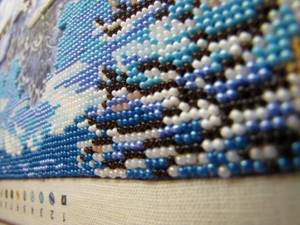
Application area
- When catching large fish, monofilament is more useful than braided line.
- If the bottom is not clean , if there are a lot of snags or shells, then a regular fishing line has a better chance of not breaking during fishing.
- The bait plays differently for monofilament and braided line. In specific conditions, a situation may well arise when in one of these cases the fish does not react to the bait at all, in another it bites perfectly.
- When fishing for a fairly large fish, it is possible that, when using a braided cord, the fishing rod will break or the fish will jump off the hook. In this case, it is recommended to use ordinary fishing line - monofilament. Due to its stretchability, it absorbs the jerks of a large predator and prevents it from falling off the hook.
- The fishing line is relatively transparent and the fish either does not see it or sees it very weakly. Therefore, it is used for those fish that can easily get scared.
- During its production, additional attention is paid to reducing friction. For some types of monofilaments, a special outer layer may be provided that reduces friction and improves strength characteristics. This plays an important role when making long casts from a spinning rod.
- When using ultra-light bait, monofilament is the best option. In such cases, it is convenient to use it not only for the main line, but also for leashes.
- For feeder fishing, monofilament is also usually used. It can be used both for the main line and for the leash.
- Conventional fishing line is traditionally preferred to be used for an ordinary float fishing rod as the main one.
- It is great for use in winter fishing . This is due to the fact that it is largely resistant to freezing.
Manufacturers of monofilament threads for needlework
On the domestic market you can find several well-known manufacturers of monofilament threads for needlework:
- Monofilament Gamma. A well-known company that produces monofilament threads at an affordable price. This spool of thread will last you a long time, but many people complain about the low strength of Gamma threads.
- Monofilament from Madeira. Manufacturer from Germany, uses 100% polyamide. These threads have proven themselves to be of high quality, but are available only in two colors - dark and transparent. Long spool, different monofilament diameters.
- Monofilament Corn. The Chinese company produces threads of average quality at an affordable price. Perfect for beginner needlewomen, durable for its price.
- Hemline monofilament. The Austrian company produces high-quality nylon threads up to 200 meters long. Sold in sets for experienced needlewomen.
[Total votes: 1 Average: 5/5]

Irina Vyshivaikina
Professional skills: Clothing designer; Artist
Brief biography and personal achievements: “I am inspired by the things that are around us.” Since childhood, I was interested in art and crafts, so I decided to devote my life to it. She received a higher education in design and released a collection of designer jewelry made from simple materials that can be found at home from any needlewoman. Afterwards, I decided to conduct master classes on creating similar accessories for everyone. She became a blogger and the author of the website domigolki.ru.
What is monofilament?
The most common are monofilament fishing lines with a round cross-section. There are products with oval, triangular, square and hexagonal sections. The diameter varies widely, from 0.03 to 4 mm and beyond. Thickness greatly affects the strength of the material.
Monofilament has characteristic qualities:
- Reliability;
- Large tensile strength;
- Friction resistance;
- Endurance to various environmental environments.
Monofilament fishing line is available in a wide range of colors, which allows it to be used in various fields of industry and the national economy.

